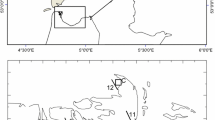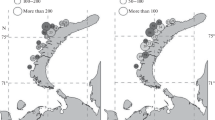Abstract
In several species of bivalve molluscs recruitment is more successful in a summer after a cold than after a mild winter. Results of a long-term monitoring program on Balgzand, a 50-km2 tidal-flat area in the westernmost part of the Wadden Sea, included a significantly negative relationship between winter temperatures and subsequent densities of Macoma balthica recruits in August. We show that this correlation may have arisen from two winter-temperature related processes: 1. Numbers of eggs spawned in April (both per female and per m2) were higher after cold than after mild winters. Results of experiments showed that this is due to higher body weights in late winter/early spring after cold than after mild winters, resulting from lower rates of weight loss at low than at high winter temperatures. 2. Densities of juvenile shrimps Crangon crangon on the tidal flats were significantly lower in springs after cold than after mild winters. Shrimps are important predators of post-larval just-settled Macoma. Numbers of Macoma recruits per spawned egg were generally between 0.001 and 0.0001 and were significantly higher at low than at high shrimp densities in late-spring. We conclude that the latter process was the decisive one.
Similar content being viewed by others
References
André, C., P. R. Jonsson & M. Lindegarth, 1993. Predation on settling bivalve larvae by benthic suspension feeders: the role of hydrodynamics and larval behaviour. Mar. Ecol. Prog. Ser. 97: 183–192.
Armonies, W. & M. Hellwig-Armonies, 1992. Passive settlement of Macoma balthicaspat on tidal flats of the Wadden Sea and subsequent migration of juveniles. Neth. J. Sea Res. 29: 371–378.
Bachelet, G., 1986. Recruitment and year-to-year variability in a population of Macoma balthica(L.). Hydrobiologia 142: 233–248.
Bahr, K., 1950. Die Ergebnisse der Miesmuscheluntersuchungen an der Ostfriesischen Küste in den Jahren 1947-1950. Veröff. Inst. Küst.-u. Binnenfisch. 68: 1–29.
Bayne, B. L., 1972. Some effects of stress in the adult on larval development of Mytilus edulis. Nature 237: 459.
Bayne, B. L., P. A. Gabbot & J. Widdows, 1975. Some effects of stress in the adults on the eggs and larvae of Mytilus edulis. J. mar. biol. Ass. UK 55: 675–689.
Bayne, B. L., D. L. Holland, M. N. Moore, D. M. Lowe & J. Widdows, 1978. Further studies on the effects of stress in the adult on the eggs of Mytilus edulis. J. mar. biol. Ass. U.K. 58: 825–841.
Beukema, J. J., 1982. Annual variation in reproductive success and biomass of the major macrozoobenthic species living in a tidal flat area of the Wadden Sea. Neth. J. Sea Res. 16: 37–45.
Beukema, J. J., 1988. An evaluation of the ABC-method (abundance/ biomass comparison) as applied to macrozoobenthic communities living on tidal flats in the Dutch Wadden Sea. Mar. Biol. 99: 425–433.
Beukema, J. J., 1991. The abundance of shore crabs Carcinus maenas(L.) on a tidal flat in the Wadden Sea after cold and mild winters. J. exp. mar. Biol. Ecol. 153: 97–113.
Beukema, J. J., 1992a. Dynamics of juvenile shrimp Crangon crangonin a tidal-flat nursery of the Wadden Sea after mild and cold winters. Mar. Ecol. Prog. Ser. 83: 157–165.
Beukema, J. J., 1992b. Expected changes in theWadden Sea benthos in a warmer world: lessons from periods with mild winters. Neth. J. Sea Res. 30: 73–79.
Beukema, J. J., 1993a. Increased mortality in alternative bivalve prey during a period when the tidal flats of the Dutch Wadden Sea were devoid of mussels. Neth. J. Sea Res. 31: 395–406.
Beukema, J. J., 1993b. Successive changes in distribution patterns as an adaptive strategy in the bivalve Macoma balthica(L.) in the Wadden Sea. Helgoländer Meeresunters. 47: 287–304.
Beukema, J. J. & G. C. Cadée, 1996. Consequences of the sudden removal of nearly all mussels and cockles from the Dutch Wadden Sea. P.S.Z.N. I: Mar. Ecol. 17: 279–289.
Beukema, J. J. & J. De Vlas, 1989. Tidal-current transport of threaddrifting postlarval juveniles of the bivalve Macoma balthicafrom the Wadden Sea to the North Sea. Mar. Ecol. Prog. Ser. 52: 193–200.
Beukema, J. J. & K. Essink, 1986. Common patterns in the fluctuations of macrozoobenthic species living at different places on tidal flats in the Wadden Sea. Hydrobiologia 142: 199–207.
Beukema, J. J., G. C. Cadée & H. Hummel, 1983. Differential variability in time and space of numbers in suspension and deposit feeding benthic species in a tidal flat area. Oceanol. Acta No Sp.: 21–26.
Beukema, J. J., K. Essink & H. Michaelis, 1996. The geographic scale of synchronized fluctuation patterns in zoobenthos populations as a key to underlying factors: climatic or man-induced. ICES J. Mar. Sci. 53: 964–971.
Bonsdorff, E., J. Mattila, C. Rönn & C.-S. Österman, 1986. Multidimensional interactions in shallow soft-bottom ecosystems; testing the competitive exclusion principle. Ophelia Suppl. 4: 37–44.
Bonsdorff, E., A. Norkko & C. Boström, 1995. Recruitment and population maintenance of the bivalve Macoma balthica(L.)-factors affecting settling success and early survival on shallow sandy bottoms. In: A. Eleftheriou et al. (eds), Biology and Ecology of Shallow Coastal Waters (Proc. 28thEMBS), Olsen & Olsen, Fredensborg: 253–260.
Dankers, N. & J. J. Beukema, 1982. Distributional patterns of macrozoobenthic species in relation to some environmental factors. In W. J. Wolff (ed.), Ecology of the Wadden Sea, Balkema, Rotterdam, 1: 69–103.
Desprez, M., G. Bachelet, J. J. Beukema, J.-P. Ducrotoy, K. Essink, J. Marchand, H. Michaelis, B. Robineau & J. G. Wilson, 1991. Dynamique des populations de Macoma balthica(L.) dans les estuaires du Nord-Ouest de l'Europe: premiè re synthè se. In M. Elliott & J.-P. Ducrotoy (eds), Estuaries and Coasts: Spatial and Temporal Intercomparisons. Olsen & Olsen, Fredensborg: 159–166.
Dijkema, R., 1992. Spatfall and recruitment of mussels (Mytilus edulis) and cockles (Cerastoderma edule) on different locations along the European coast. ICES C.M. 1992/K:45 (Shellfish Committee).
Hancock, D. A., 1973. The relationship between stock and recruitment in exploited invertebrates. Rapp. P.-v. Réun. Cons. perm. Int. Explor. Mer 164: 113–131.
Helm, M. M., D. L. Holland & R. R. Stephenson, 1973. The effect of supplementary algal feeding of a hatchery breeding stock of Ostrea edulisL. on larval vigour. J. mar. biol. Ass. U.K. 53: 673–684.
Honkoop, P. J. C. & J. J. Beukema, 1997. Loss of body mass in winter in three intertidal bivalve species: an experimental and observational study of the interacting effects between water temperature, feeding time and feeding behaviour. J. exp. mar. Biol. Ecol. 212: 277–297.
Honkoop, P. J. C. & J. van der Meer, 1997a. Reproductive output of Macoma balthicapopulations in relation to winter-temperature and intertidal-height mediated changes of body mass. Mar. Ecol. Prog. Ser. 149: 155–162.
Honkoop, P. J. C. & J. van derMeer, 1997b. Experimentally induced effects of water temperature and immersion time on reproductive output of bivalves in the Wadden Sea. J. exp. mar. Biol. Ecol. 220: 227–246.
Honkoop, P. J. C., J. van der Meer, J. J. Beukema & D. Kwast, 1998. Does temperature-influenced egg production predict the recruitment in the bivalve Macoma balthica? Mar. Ecol. Prog. Ser. 164: 229–235.
Jensen, K. T. & J. N. Jensen, 1985. The importance of some epibenthic predators on the density of juvenile benthic macrofauna in the Danish Wadden Sea. J. exp. mar. Biol. Ecol. 89: 157–174.
Keus, B., 1986. De predatie van de garnaal (Crangon crangon) op het broed van het nonnetje (Macoma balthica). Interne Verslagen NIOZ, Texel 1986-5: 1–43.
Kraeuter, J. N., M. Castagna & R. van Dessel, 1982. Egg size and larval survival of Mercenaria mercenaria(L.) and Argopecten irradians(Lamarck). J. exp. mar. Biol. Ecol. 56: 3–8.
Kreger, D., 1940. On the ecology of Cardium edule.Archs néerl. Zool. 4: 157–200.
Kristensen, I., 1957. Differences in density and growth in a cockle population in the DutchWadden Sea. Archs néerl. Zool. 12: 351–453.
Kühl, H., 1955. Studien über die Klaffmuschel Mya arenaria3. Das Junggut. Arch. Fisch. Wiss. 6: 33–44.
Mattila, J., E. B. 'Olafsson & A. Johansson, 1990. Predation effects of Crangon crangonon benthic infauna on shallow sandy bottoms-an experimental study from southern Sweden. In M. Barnes & R. N. Gibson (eds), Proc. 24th Eur. Mar. Biol. Symp., Aberdeen Univ. Press, Aberdeen: 503–516.
Möller, P., 1986. Physical factors and biological interactions regulating infauna in shallow boreal areas. Mar. Ecol. Prog. Ser. 30: 33–47.
Möller, P. & R. Rosenberg, 1983. Recruitment, abundance and production of Mya arenariaand Cardium edulein marine shallow waters, western Sweden. Ophelia 22: 33–55.
Pihl, L., 1985. Food selection and consumption ofmobile epibenthic fauna in shallow marine areas. Mar. Ecol. Prog. Ser. 22: 169–179.
Pihl, L. & R. Rosenberg, 1984. Food selection and consumption of the shrimp Crangon crangonin some shallow marine areas in western Sweden. Mar. Ecol. Prog. Ser. 15: 159–168.
Plagmann, J., 1939. Ernährungsbiologie der Garnele (Crangon vulgareFabr.). Helgoländer wiss. Meeresunters. 2: 113–162.
Raffaelli, D., A. Conacher, H. McLachlan & C. Emes, 1989. The role of epibenthic crustacean predators in an estuarine food web. Est. coast. Shelf Sci. 28: 149–160.
Reise, K., 1977. Predator exclusion experiments in an intertidal mud flat. Helgoländer wiss. Meeresunters. 30: 263–271.
Reise, K., 1985. Tidal flat ecology. An experimental approach to species interactions. Springer Verlag, Berlin, 191 pp.
Savage, R. E., 1956. The great spatfall of mussels (Mytilus edulisL.) in the river Conway estuary in spring 1940. Fish. Invest., London (2) 20: 1–22.
Smidt, E. L. B., 1951. Animal production in the Danish Wadden Sea. Meddr Kommn danm. Fisk.- og Havunders. (Serie Fiskeri) 11: 1–151.
Thamdrup, H. M., 1935. Beiträge zur Ökologie der Wattenfauna auf experimenteller Grundlage. Meddr Kommn danm. Fisk- og Havunders. (Serie Fiskeri) 10: 1–125.
Yankson, K., 1986. Reproductive cycles of Cerastoderma glaucum(Bruguiè re) and C. edule(L.) with special reference to the effects of the 1981-82 severe winter. J. moll. Stud. 52: 6–14.
Young, E. F., G. R. Bigg & A. Grant, 1996. A statistical study of environmental influences on bivalve recruitment in the Wash, England. Mar. Ecol. Prog. Ser. 143: 121–129.
Zwarts, L., 1991. Seasonal variation in body weight of the bivalves Macoma balthica, Scrobicularia plana, Mya arenariaand Cerastoderma edulein the Dutch Wadden Sea. Neth. J. Sea Res. 28: 231–245.
Rights and permissions
About this article
Cite this article
Beukema, J.J., Honkoop, P.J.C. & Dekker, R. Recruitment in Macoma balthica after mild and cold winters and its possible control by egg production and shrimp predation. Hydrobiologia 375, 23–34 (1998). https://doi.org/10.1023/A:1017025526098
Issue Date:
DOI: https://doi.org/10.1023/A:1017025526098




